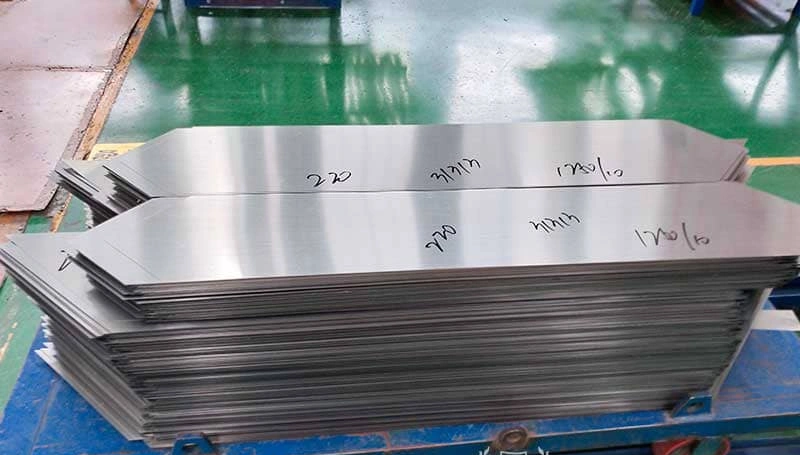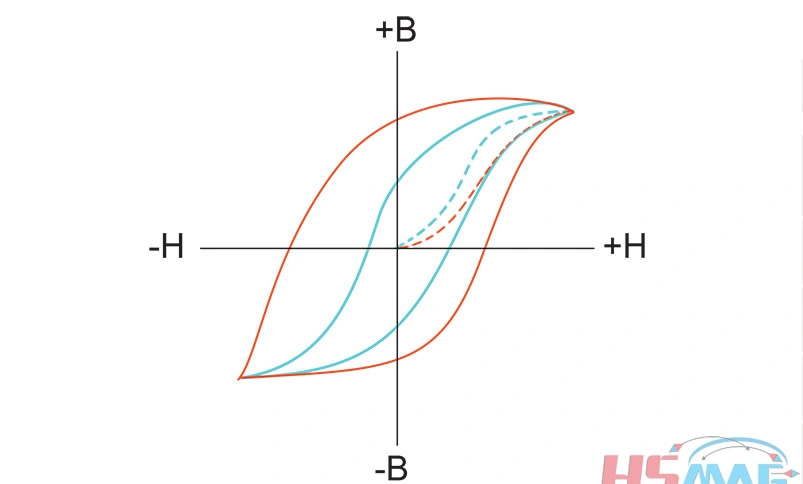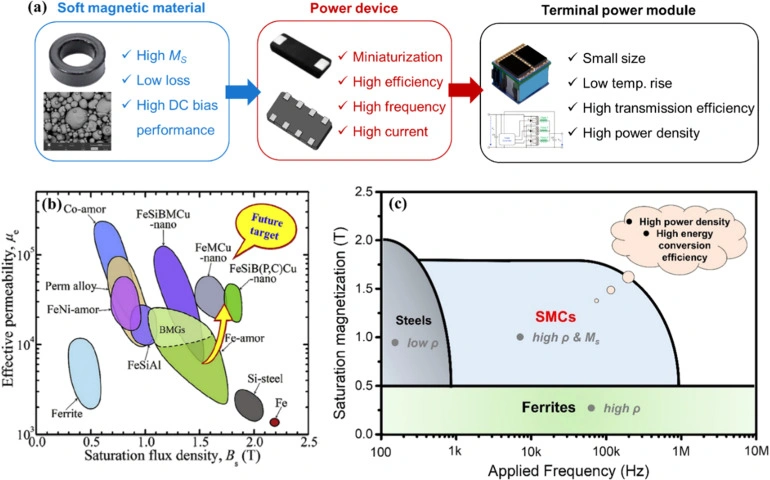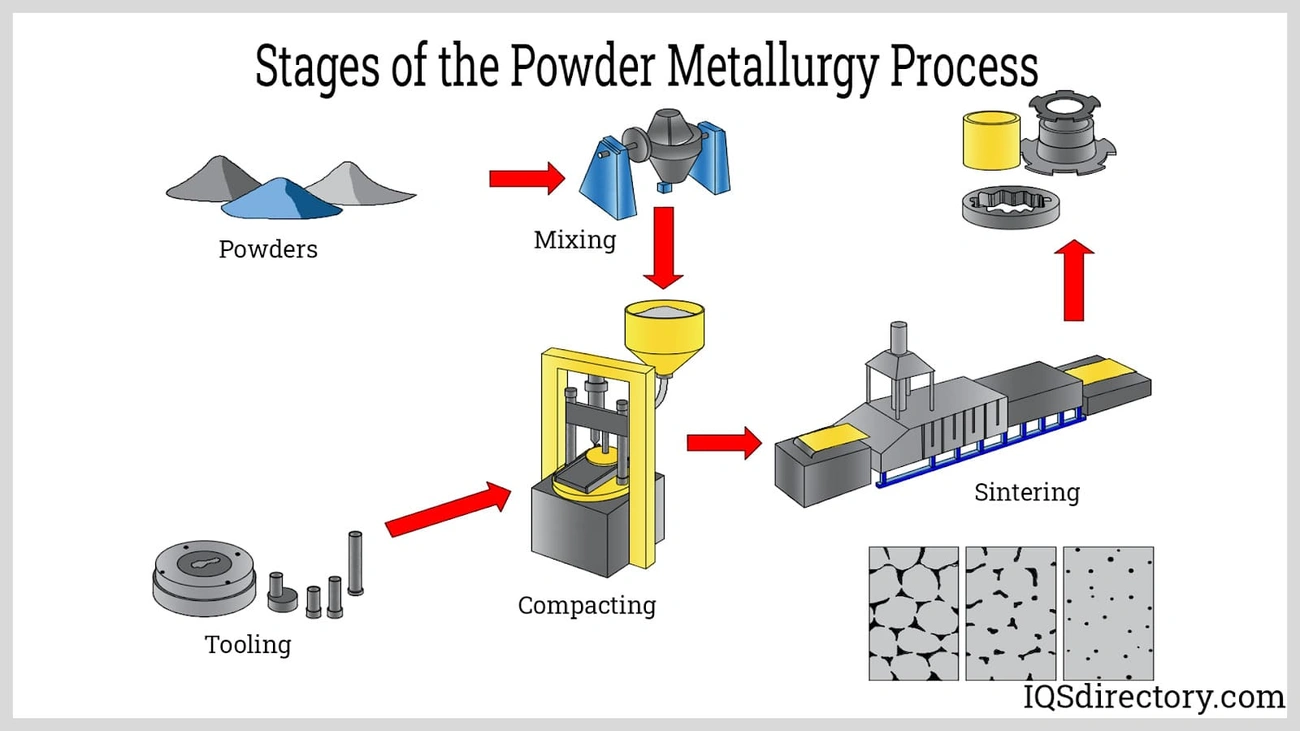
Soft magnetic materials are the foundations of almost every electrical device, from smartphones and computers to electric generators and aerospace equipment. These materials know how to magnetize and demagnetize easily, with an intrinsic coercivity less than 1000 Am-1. Their remarkable versatility makes them vital components in modern electronic and electrical systems. They contribute significantly to electrical energy’s generation, transmission, conversion, and storage.
Specific properties of soft magnetic materials make them perfect for engineering applications. Relative permeability serves as the most important parameter for measuring merit. This property shows how quickly the material responds to an applied magnetic field. Low hysteresis losses combined with permeability allow these materials to work in electrical applications and eco-friendly energy supply with minimal energy loss. You’ll find soft magnetic materials in transformers, inductors, switch-mode power supplies, electric motors, magnetic shielding, and signal transmitters and receivers. Industries are moving toward the electrification of transport, households, and manufacturing rapidly. Minimizing energy losses has become a vital concern, which makes optimizing soft magnetic materials through powder metallurgy and metal injection technology especially important.
Fundamental Properties of Soft Magnetic Materials

Soft magnetic materials differ from hard ones mainly because of how they behave magnetically. These unique properties make them perfect for uses that need quick magnetization and demagnetization cycles.
Low coercivity and high permeability explained
Soft magnetic materials stand out because of their low coercivity and high permeability. Coercivity shows how much magnetic field you need to demagnetize a material after it reaches saturation. Soft magnetic materials have an intrinsic coercivity below 1000 Am-1. This low coercivity means these materials demagnetize easily and need minimal energy for the process.
Permeability measures how well a material responds to an applied magnetic field. It’s calculated as the ratio of magnetic induction output (B) to magnetic field strength input (H). This measurement serves as the key quality indicator for soft magnetic materials. Nickel-iron alloys show much higher permeability than other soft magnetic alloys. This makes them ideal for applications where space is limited or miniaturization matters.
At microscopic levels, these materials magnetize easily because their domain walls move freely. Any defects or impurities can limit domain wall movement and increase coercivity. Quality soft magnetic materials need very few impurities and defects to allow easy domain wall movement.
Magnetization curve and hysteresis loop behavior
B-H curves or hysteresis loops show how soft magnetic materials magnetize. These materials follow a specific magnetization curve under an alternating magnetic field. The material magnetizes as the field gets stronger until it hits the saturation flux density. Beyond this point, stronger fields won’t increase magnetization further.
Soft magnetic materials have narrow hysteresis loops. This shows they lose minimal energy during magnetization cycles. The narrow loop has these features:
- Low remanent induction (residual magnetism when the field is removed)
- Low coercivity (small field required to demagnetize)
- High initial permeability (μi) and maximum permeability (μmax)
The hysteresis loop’s area represents energy lost in one complete magnetization cycle. Soft magnetic materials have much smaller areas than hard ones, which can be 10,000 times wider. Smaller loop areas mean lower energy losses, which is perfect for applications needing frequent magnetization reversals.
Electrical resistivity and its role in AC losses
Electrical resistivity plays a vital role in how soft magnetic materials perform, especially with AC applications. These materials lose energy in three main ways when exposed to alternating magnetic fields:
- Hysteresis loss – Relates to the area within the hysteresis loop
- Eddy current loss – Comes from induced electrical currents and their resistive losses
- Anomalous loss – Links to domain wall movement within the material
Eddy current losses become a big deal at higher frequencies. You can calculate these losses using: Pe = (Ke × Induction² × Freq² × thickness²) / resistivity. Materials with higher resistivity work better in AC applications because they lose less energy.
Powder metallurgy and metal injection technology use several methods to boost resistivity and cut losses. One way involves making components from insulated ferromagnetic particles. You need fine particles with good insulation to minimize eddy currents, particularly in high-frequency uses. Research shows that resistivity just one level higher than pure iron (about 0.1 μΩm) keeps eddy current losses low at frequencies under 100 Hz.
Manufacturers also use lamination techniques to reduce eddy current losses. Thinner materials help minimize eddy current effects. Adding silicon to iron increases electrical resistivity and reduces core losses by lowering magnetocrystalline anisotropy.
Material Classification Based on Composition

The magnetic behavior of soft magnetic materials depends heavily on their composition. Different alloying elements and manufacturing methods affect properties like permeability, coercivity, and electrical resistivity. These properties determine which materials work best for specific uses.
Iron-Silicon Alloys (Fe-Si) for transformer cores
Silicon steel, also known as electrical steel or transformer steel, ranks among the most accessible soft magnetic materials for electrical applications. Adding silicon to iron makes the electrical resistivity much higher, which helps reduce eddy current losses. The saturation magnetization and Curie temperature decrease slightly, but these alloys remain the best choice for applications between 50 Hz and several hundred Hz.
Silicon steel proved to be a big improvement over solid iron cores in early transformers. The material’s better permeability and lamination techniques help reduce circulating currents and overheating – problems that affected solid iron designs. The processing conditions determine whether Fe-Si alloys become Grain-Oriented (GO) or Non-Oriented (NO) variants. Transformers use GO silicon steel, while electric motors use NO variants.
Cold rolling makes silicon steel stronger and more durable during assembly. High-temperature annealing removes impurities and makes the material softer and more ductile. The grain orientation can boost flux density by about 30%, showing how processing methods affect magnetic performance.
Nickel-Iron Alloys (Permalloy) for shielding
Bell Telephone Laboratories physicist Gustav Elmen invented Permalloy in 1914. This material contains about 80% nickel and 20% iron. These proportions create remarkable magnetic properties, especially its high magnetic permeability—about 100,000 compared to several thousand for regular steel. Nickel and iron form uniform solid solutions across compositions from 35% to 80% nickel.
Permalloy stands out for its low coercivity, near-zero magnetostriction, and strong anisotropic magnetoresistance. The electrical resistivity changes up to 5% based on the strength and direction of magnetic fields. With the right composition and heat treatment, Permalloy’s permeability can reach 1,200,000, making it one of the softest magnetic materials.
Permalloy’s poor ductility and workability limit its use. Applications needing complex shapes often use other high-permeability alloys like mu-metal instead. Still, Permalloy works great in transformer laminations, magnetic recording heads, and magnetic shielding.
Soft Ferrites for high-frequency applications
Soft ferrites combine iron oxide (Fe₂O₃) with other metal oxides to form ceramic compounds. Their resistivity measures several orders of magnitude higher than metallic soft magnetic materials. This makes them perfect for applications up to 1 MHz, where energy losses need to stay low.
Manganese-Zinc (MnZn) and Nickel-Zinc (NiZn) make up the two main types of soft ferrites. MnZn ferrites have high permeability and work well in power supply inductors and power conversion transformers. NiZn ferrites offer higher resistivity, making them ideal for radio frequency applications and electromagnetic interference filters. People use MnZn ferrites below 1 MHz, while NiZn ferrites can handle higher frequencies but with lower permeability and saturation.
Amorphous and Nanocrystalline Alloys
Rapid solidification techniques create amorphous alloys, or metallic glasses, by preventing long-range atomic ordering. The lack of a crystal structure leads to high resistivity and no magnetocrystalline anisotropy. Most commercial amorphous soft magnets come in three types: Fe-based, Co-based, and (Fe, Ni)-based, containing 75-90% ferromagnetic elements by weight.
Fe-based amorphous alloys provide the highest saturation induction (about 1.6 T) among amorphous materials at the lowest cost. Their iron loss measures just one-third of traditional Fe-Si steel, which means better efficiency in power transformers. Co-based versions have lower saturation induction (under 0.8 T) but offer higher permeability and almost zero magnetostriction.
Nanocrystalline alloys mark another step forward through controlled heat treatment of amorphous materials. Adding elements like Nb and Cu to Fe-based amorphous alloys allows controlled crystallization. This creates evenly distributed nanocrystals about 10 nm in size within an amorphous matrix. These materials perform even better than amorphous ones, with higher permeability and lower coercivity, though their saturation induction drops slightly to about 1.2 T.
AC and DC Application Requirements
Soft magnetic materials have two main categories based on their magnetization process. These categories – AC and DC – need different material properties to work best.
AC applications: transformers, inductors, SMPS
Soft magnetic materials in AC applications go through constant magnetization cycles between directions. These applications need to be energy efficient and minimize losses during hysteresis loop cycles.
Power transformers are a key AC application that convert electrical energy between voltage-current combinations and separate primary and secondary windings. You’ll find two main types: low-frequency transformers (below 1000 Hz) and high-frequency transformers (above 1000 Hz). Switch-mode power supplies (SMPS), also known as DC-DC converters, are another important use where soft magnetic materials make up the core of small transformers on circuit boards.
Inductors and chokes employ soft magnetic materials to store electrical energy as magnetic energy. The core’s flux build-up depends on the current applied and the material permeability. Material choice substantially affects how power inductors work when they transfer direct current energy while blocking high-frequency alternating current. Today’s inductors need better inductance, smaller size, and improved efficiency to meet tough application requirements.
Soft ferrites work exceptionally well in high-frequency applications (above 100 kHz) because their high electrical resistivity limits eddy current losses. Metal-based soft magnetic composites (SMCs) offer better temperature stability, DC bias resistance, and electromagnetic compatibility, though they cost more.
DC applications: magnetic shielding, solenoids
DC applications usually magnetize soft magnetic materials to do a specific job before demagnetizing them. These applications need high permeability more than AC loss characteristics.
Magnetic shielding is a major DC application where materials with high permeability protect devices from external fields. Better permeability improves the shield’s effectiveness, measured by its shielding factor (S). Larger shields need either higher material permeability or thicker walls to stay effective.
Solenoid switches and electromagnets make up another key DC application group. Alloys containing 49% nickel, like High Permeability 49, show high initial and maximum permeability with low core loss. These properties make them great for solenoid cores and control devices. Iron-cobalt alloys work best in applications needing maximum magnetic output per unit weight, such as aircraft generators and magnetic bearings, thanks to their exceptionally high saturation flux density.
Soft magnetic materials often help permanent magnet devices by channeling flux lines or creating return paths for magnetic fields. MRI scanners use soft magnetic materials to create a yoke that stops self-demagnetizing fields from reducing the scanner gap field.
Performance trade-offs in different use cases
Engineers must balance multiple factors when choosing soft magnetic materials for specific applications. High-performance power inductors need materials with high saturation current (Isat) and temperature rising current (Irms) values. The material’s saturation magnetization affects Isat directly, while Irms relates to reducing losses and heat.
Coercivity becomes the key material parameter at low frequencies (below about 10 kHz) where hysteresis losses dominate. Electrical resistivity matters more at higher frequencies (above 100 kHz) when eddy current losses take over. Common mode chokes can use either ferrites or nanocrystalline cores. Ferrites work better around 100 kHz, while nanocrystalline materials offer wider-band attenuation in smaller packages with lower copper resistance.
DC bias performance – keeping enough permeability under large DC fields – matters a lot for high-power devices with substantial pre-magnetization. This feature becomes especially important in electric vehicle and aerospace applications where components work under heavy DC loads.
Loss Mechanisms and Performance Metrics
Energy losses are a vital factor to consider when evaluating soft magnetic materials for engineering applications. These losses affect efficiency and determine how well the material performs thermally at different frequencies.
Hysteresis loss and coercivity correlation
Hysteresis loss happens during magnetization cycles and is associated directly with coercivity values. The area inside the hysteresis loop shows this loss component, which represents energy lost in one complete magnetization cycle. Materials that have higher coercivity values tend to show increased hysteresis losses. This is why low coercivity remains the main goal when designing soft magnetic materials.
The losses increase substantially as the process shifts from domain wall movement to magnetization rotation. Research has found higher hysteresis losses in areas where classical domain theory suggests minimal losses should exist. This finding explains the complex link between microstructure and magnetic behavior.
Eddy current loss and resistivity optimization
Eddy current losses become more important at higher frequencies. We can express these losses mathematically as: Pe = (Ke × Induction² × Freq² × thickness²) / resistivity. The eddy current’s effect gets stronger as frequency rises, which makes the hysteresis loop area larger.
Material’s resistivity plays a significant role in reducing these losses. Powder metallurgy and metal injection technology use these methods to increase resistivity:
- Using insulated ferromagnetic particles
- Adding lamination to reduce eddy current paths
- Including silicon or other elements to increase bulk resistivity
Soft magnetic composites (SMCs) have eddy current losses that split into inter-particle and intra-particle components. The skin effect becomes noticeable when particle size goes beyond 50 μm and frequencies exceed 3 kHz. This causes eddy current loss to rise non-linearly with frequency.
Anomalous loss and domain wall motion
Anomalous losses (also called excess losses) make up much of the total energy loss—about 90% in amorphous ribbons and 50% in grain-oriented silicon-iron. These losses happen mainly because domain walls don’t move uniformly.
Moving domain walls create local eddy currents, which cause energy loss within and around these boundaries. This loss type usually increases with frequency to a power of 1.5. Changes in the number of active domain walls cause this relationship.
Magnetostriction adds substantially to anomalous losses. Domain wall movement in magnetic materials creates viscous resistance through magnetostriction, which leads to magnetic energy loss. Yes, it is worth noting that magnetostriction creates energy losses that follow the same frequency pattern as anomalous eddy current losses.
Engineers need to understand these loss mechanisms as efficiency requirements keep rising along with operating frequencies.
Processing Techniques and Their Impact

The performance of soft magnetic materials depends heavily on their manufacturing methods. These processes control microstructure, grain orientation, and electrical resistivity. Different techniques help enhance magnetic properties and create various component shapes.
Powder metallurgy for shape flexibility
Powder metallurgical manufacturing opens up new possibilities that go beyond traditional techniques. This method creates near net shapes that need minimal finishing work. You can choose from a wider range of materials than conventional methods to make components with special properties in different shapes. On top of that, powder metallurgy helps add extra functions and reduces iron losses to boost magnetic performance. Silicon Iron Powder Metallurgy technology makes both soft magnetic materials and permanent magnets with excellent magnetic properties.
Metal injection molding for complex geometries
Metal injection molding (MIM) takes the best parts of plastic injection molding and combines them with powder metallurgy’s material options. The result is almost fully dense, net-shaped components made from engineering materials of all types. MIM shines when making intricate, complex-shaped parts that would be tough to create just by pressing. The process costs less than machined parts, especially for complex shapes, and saves money through mass production. MIM works great with many soft magnetic materials – pure iron, soft magnetic stainless steel, Fe-Si alloy, Fe-Co alloy, and Fe-Ni alloy.
Annealing and grain orientation control
Annealing treatments play a crucial role in shaping the magnetic properties of soft magnetic materials. The process gets rid of internal stresses and makes materials stronger. Fe-6.5 wt% Si alloys made through selective laser melting show interesting behavior. Annealing between 800-1000°C slightly weakens textures without much grain growth. The temperature at 1100°C causes unusual grain growth and creates large Goss ({110}<001>) and Cube ({100}<001>) grains. This leads to a coarser microstructure and better texture. Core plate annealing helps line up the grain structure in laminations and cuts down hysteresis losses by creating better paths for magnetic flux.
Lamination and coating for eddy current reduction
Lamination technology beats surface coating alone when it comes to reducing eddy current losses. The eddy current losses drop by a factor of 1/n² as lamination gets thinner, where n stands for the number of laminations. Laminated cores made from thin magnetic material sheets work really well at low frequencies to cut eddy current loss. These sheets get their insulation from thin oxide layers that keep eddy currents within single laminations. Soft magnetic composites use electrically insulating coatings on each particle to reduce eddy current losses. This creates materials with high resistivity that work great in high-frequency applications.
Selection Criteria for Engineering Applications
Engineers need to balance multiple factors when picking the right soft magnetic materials for their projects. The biggest challenge lies in finding materials with the right properties without getting too picky about features that can get pricey.
Choosing materials based on frequency and flux density
The frequency range shapes most material selection choices. Silicon steels work best at low frequencies (below 1000 Hz), while soft ferrites excel at high frequencies (above 1 MHz) because of their better resistivity. Amorphous and nanocrystalline materials hit the sweet spot between these extremes with their ideal mix of properties. The operating flux density also needs shape material choices, with Fe-Co alloys delivering the highest saturation induction when weight matters most.
Cost-performance trade-offs in industrial design
Different industries have different views on material costs. The soft magnetic materials market reached $18 billion in 2016, showing its economic weight. Silicon steels make up about 60% of all soft magnetic material use and give great value for money in large-scale projects. Fe-Ni alloys offer better permeability but cost more [31]. Better energy efficiency makes premium materials worth it – the US wastes about $2 billion each year just from inefficient transformers and motors.
Soft magnetic materials examples in real-world devices
Here’s how these materials work in actual devices:
- NASA’s Generalized Intelligent Motor Controller uses bendable soft magnetic materials in inductors that generate 20× less heat and don’t need separate cooling systems
- Cars need different materials for specific parts: Fe-P for motor frames, Fe-Si for pole pieces, and stainless steel for ABS sensor rings
- Medical MRI machines use soft magnetic materials as flux-channeling yokes
Conclusion
Soft magnetic materials are the building blocks of our increasingly electrified world. These materials can magnetize and demagnetize with ease, making them crucial in electronics of all types – from everyday gadgets to complex aerospace systems. This piece explores how key properties like low coercivity, high permeability, and proper electrical resistivity make these materials work in specific engineering uses.
Material composition plays a huge role in performance. Fe-Si alloys work great in transformers because they balance cost and performance well. Ni-Fe alloys shine in shielding applications with their exceptional permeability. Soft ferrites might have lower saturation, but they perform better at high frequencies. On top of that, trailblazing solutions like amorphous and nanocrystalline alloys expand performance limits with their unique microstructural features.
Engineers ended up choosing materials by weighing several factors. We used operating frequency ranges as the main guide – silicon steels rule low-frequency applications while ferrites become vital at higher frequencies. Flux density needs, costs, and specific application requirements help narrow down the choices even further.
Processing techniques substantially change final material properties. Powder metallurgy gives shape flexibility while keeping the desired magnetic traits. Metal injection molding takes things further by allowing complex shapes with near-full density. Heat treatment and grain orientation control optimize the microstructure. Lamination and particle coating techniques cut down eddy current losses at different frequencies.
Powder metallurgy combined with metal injection technology has changed manufacturing possibilities for soft magnetic parts. Engineers can now create previously impossible shapes while keeping or improving magnetic performance. These advanced methods let them strike the right balance between magnetic properties, mechanical strength, and cost.
Electronic devices keep getting smaller and more efficient, which puts more pressure on soft magnetic materials. Future developments will focus on expanding performance limits through microstructural engineering, new compositions, and better processing techniques. These materials’ progress remains vital for advances in electrical engineering, eco-friendly energy tech, and many other fields that need efficient electromagnetic energy conversion.
Key Takeaways
Understanding soft magnetic materials is crucial for engineers working with electrical systems, as these materials enable efficient energy conversion with minimal losses across diverse applications from transformers to electric vehicles.
• Low coercivity and high permeability define soft magnetic materials – Materials with coercivity under 1000 Am-1 magnetize/demagnetize easily, making them ideal for AC applications requiring frequent magnetic reversals.
• Material selection depends primarily on operating frequency – Silicon steels dominate below 1000 Hz, ferrites excel above 1 MHz, while amorphous alloys bridge the gap with superior efficiency.
• Three loss mechanisms determine performance: hysteresis, eddy current, and anomalous losses – Higher resistivity materials reduce eddy current losses, while low coercivity minimizes hysteresis losses.
• Advanced processing techniques enable complex geometries with optimized properties – Powder metallurgy and metal injection molding create intricate shapes while controlling grain orientation and electrical resistivity.
• Cost-performance trade-offs guide industrial material selection – Silicon steels offer excellent value for large-scale applications, while premium Fe-Ni and Fe-Co alloys justify higher costs in specialized applications.
The evolution toward electrification across industries makes optimizing soft magnetic materials increasingly critical for achieving energy efficiency goals and enabling next-generation electrical systems.
FAQs
Q1. What are some common applications of soft magnetic materials? Soft magnetic materials are used in a wide range of applications, including transformers, inductors, electric motors, magnetic shielding, and signal transmitters/receivers. They are essential in devices that require frequent magnetization and demagnetization cycles, from low-frequency to high-frequency applications up to 500 GHz.
Q2. How do soft magnetic materials differ from hard magnetic materials? Soft magnetic materials have low coercivity (typically less than 1000 Am-1) and high permeability, allowing them to be easily magnetized and demagnetized. This makes them ideal for applications requiring rapid magnetic field changes, unlike hard magnetic materials which maintain their magnetization and are used for permanent magnets.
Q3. What are the main types of losses in soft magnetic materials? The three main types of losses in soft magnetic materials are hysteresis loss, eddy current loss, and anomalous loss. Hysteresis loss is related to the material’s coercivity, eddy current loss is associated with induced electrical currents, and anomalous loss is connected to domain wall movement within the material.
Q4. How does frequency affect the choice of soft magnetic materials? The operating frequency significantly influences material selection. Silicon steels are preferred for low frequencies (below 1000 Hz), while soft ferrites are essential for high frequencies (above 1 MHz) due to their superior resistivity. Amorphous and nanocrystalline materials often provide ideal properties for intermediate frequencies.
Q5. What processing techniques are used to enhance soft magnetic material properties? Several processing techniques are employed to optimize soft magnetic material properties, including powder metallurgy for shape flexibility, metal injection molding for complex geometries, annealing for grain orientation control, and lamination or particle coating for eddy current reduction. These methods allow for precise control of microstructure and magnetic properties.
